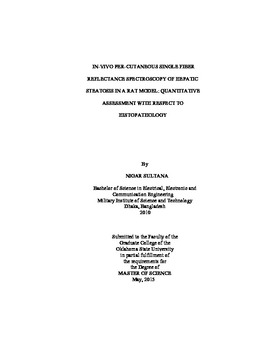| dc.description.abstract | The assessment of hepatic steatosis has implications on liver transplantation.Reflectance spectroscopy using single fiber is a minimally-invasive technique applied to probing of biological tissues for extracting tissue optical properties. The aim of this study is to evaluate if per-cutaneous in vivo single fiber reflectance spectroscopy (SfRS) could identify steatotic liver from lean liver and if SfRS could assess the grading of lipid level accumulated in liver in a diet induced rat model. Twelve rats were separated to four in the control group that were fed normaldiet and eight in the test group that were fed methionine-choline-deficient (MCD) diet. Percutaneous SfRS of the rat livers was performed under trans-abdominal ultrasound guidance and respiration gated data acquisition in day-0, day-13, day-27, day-41, and day-55. At each of the days of 13, 27, 41, and 55, one control rat and two test rats were euthanized after SfRS for collecting histopathology samples. The SfRS spectrum over 540-1000 nm was off-line processed for estimations of hemoglobin oxygen saturation, total hemoglobin concentration, lipid composition, effective scattering amplitude and power of the locally sampled liver parenchyma. Histopathology results of the twelve rats determined that all four control rats euthanized respectively on day 13, 27, 41 and 55 had insignificant lipid accumulation, two test rats euthanized on day 13 and another test rat euthanized on day 27 had mild lipid accumulation, one test rats euthanized on day 27 had moderate lipid accumulation, and four test rats, two test rats euthanized on day 41 and another two test rats euthanized on day 55 had severe lipid accumulation. SfRS results of the 4 rats originated in the control group and 8 test rats were compared and the steatotic livers shows a decreasing slope compares to normal liver. The total hemoglobin concentration also decreases as the lipid accumulation increases, starting 216.54�67.2 1???? in insignificant steatosis and ended up with 77.33�34.97???? in severe steatotic liver. There is an increase in scattering amplitude and power, scattering power changed as 0.33 � 0.0025 in insignificant, 34 � 0.0030 for mild, 0.35 on moderate and 0.35�0.0026 on severe steatotic liver at their respective days of euthanasia. | |
